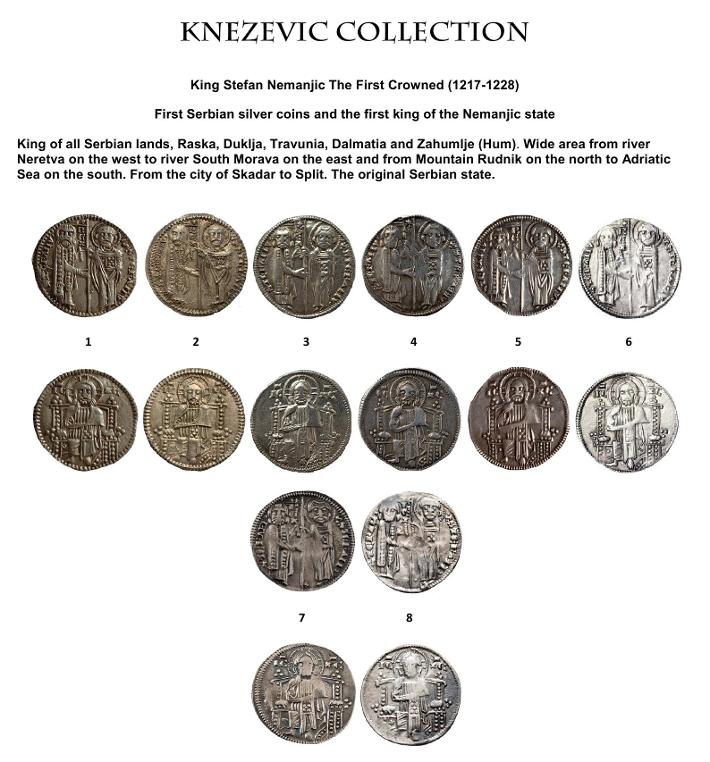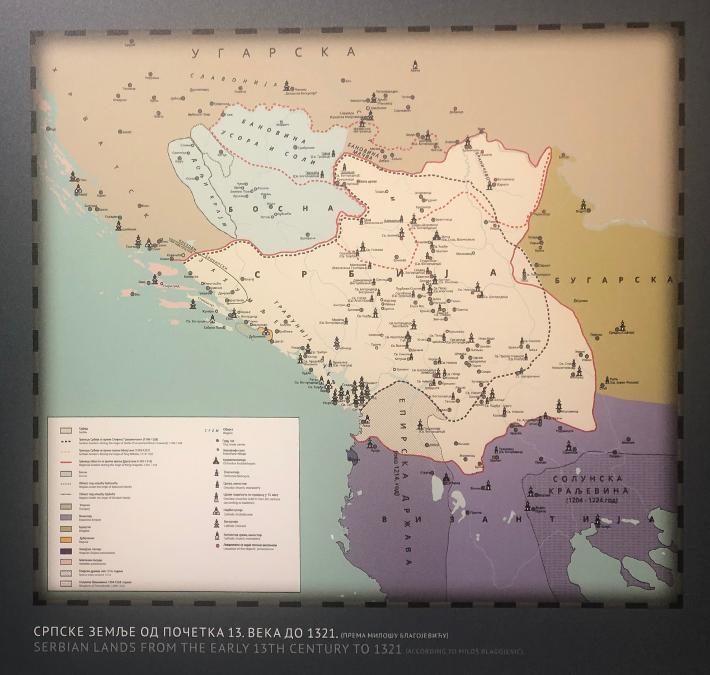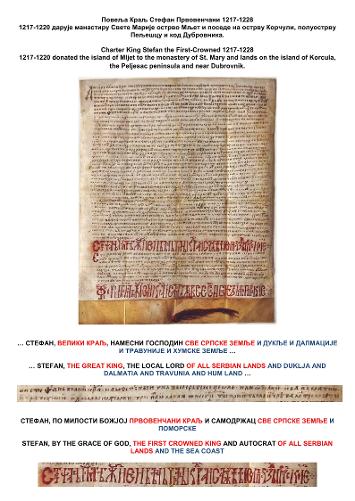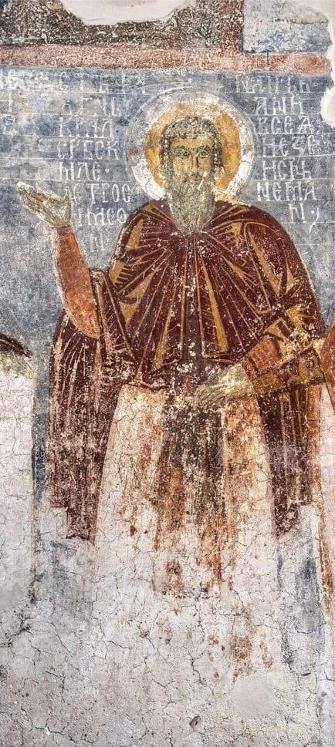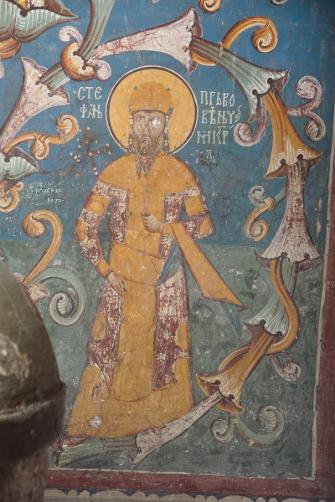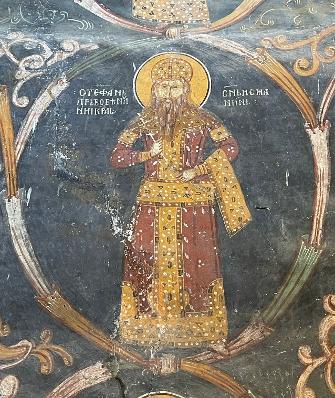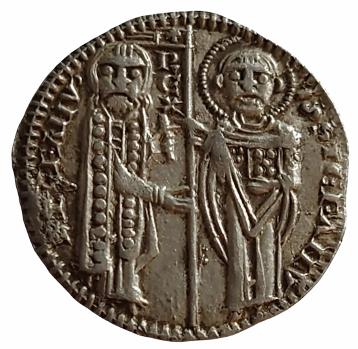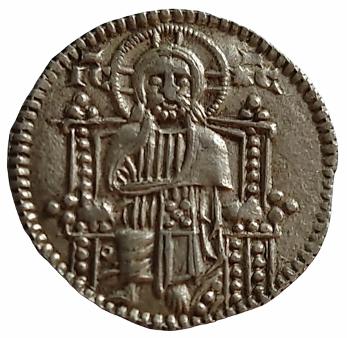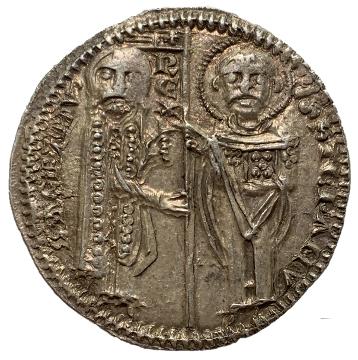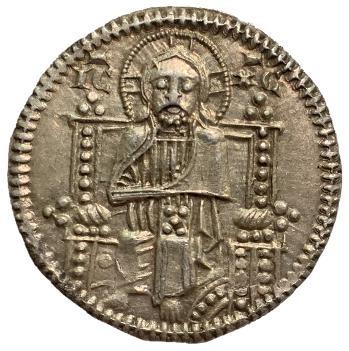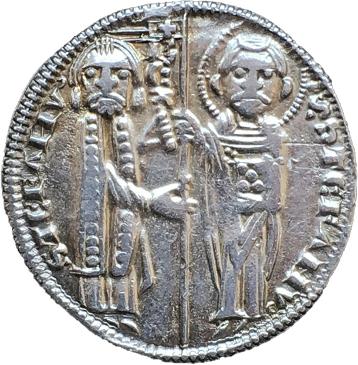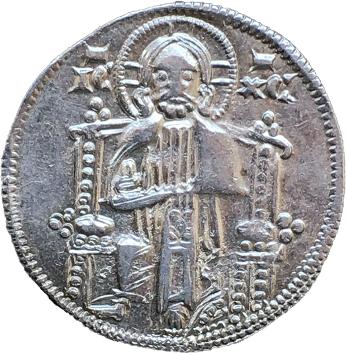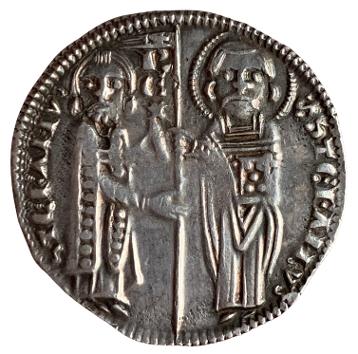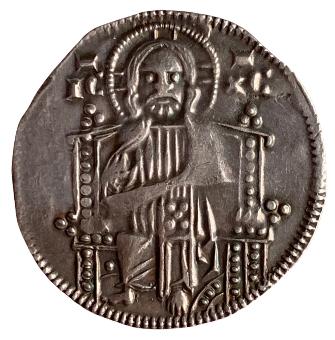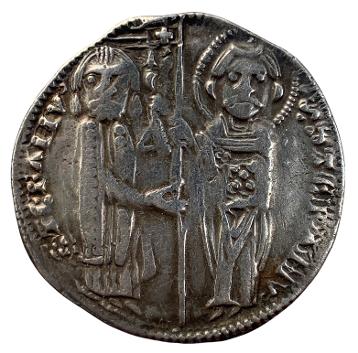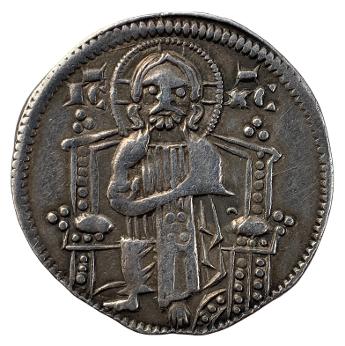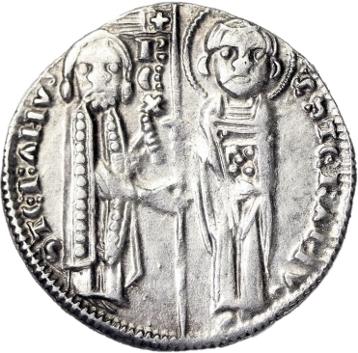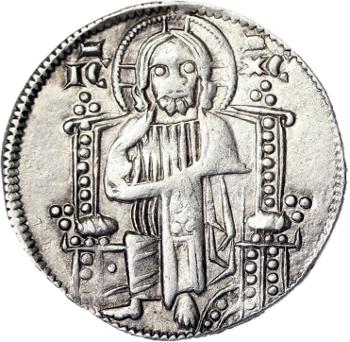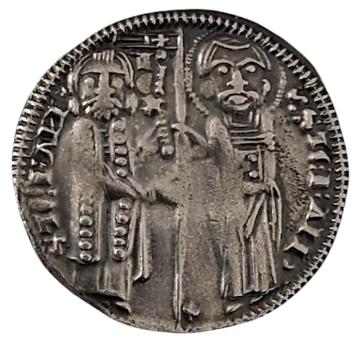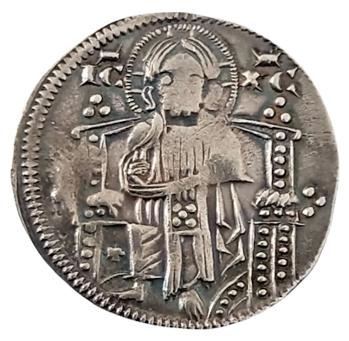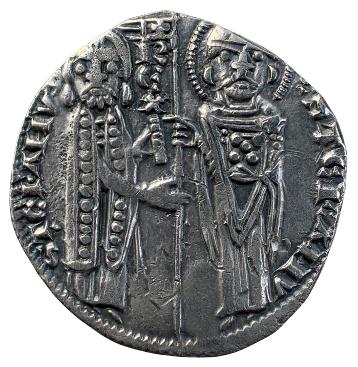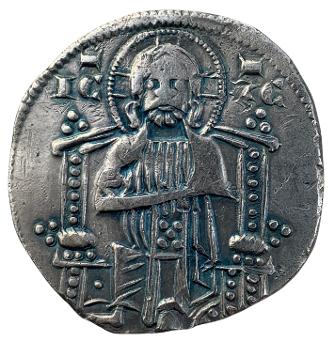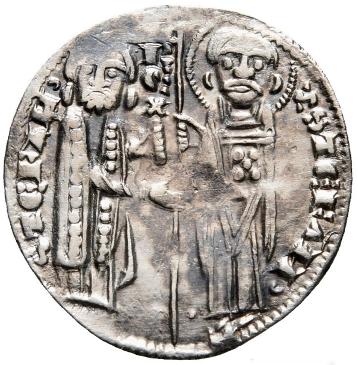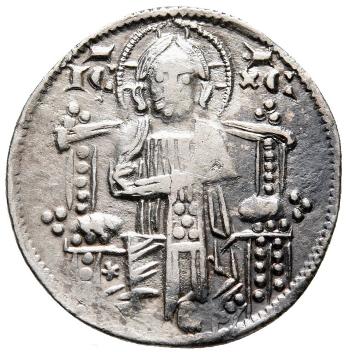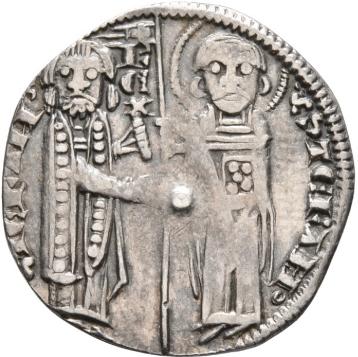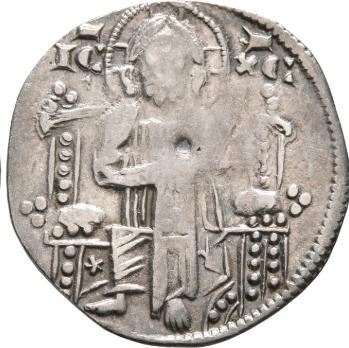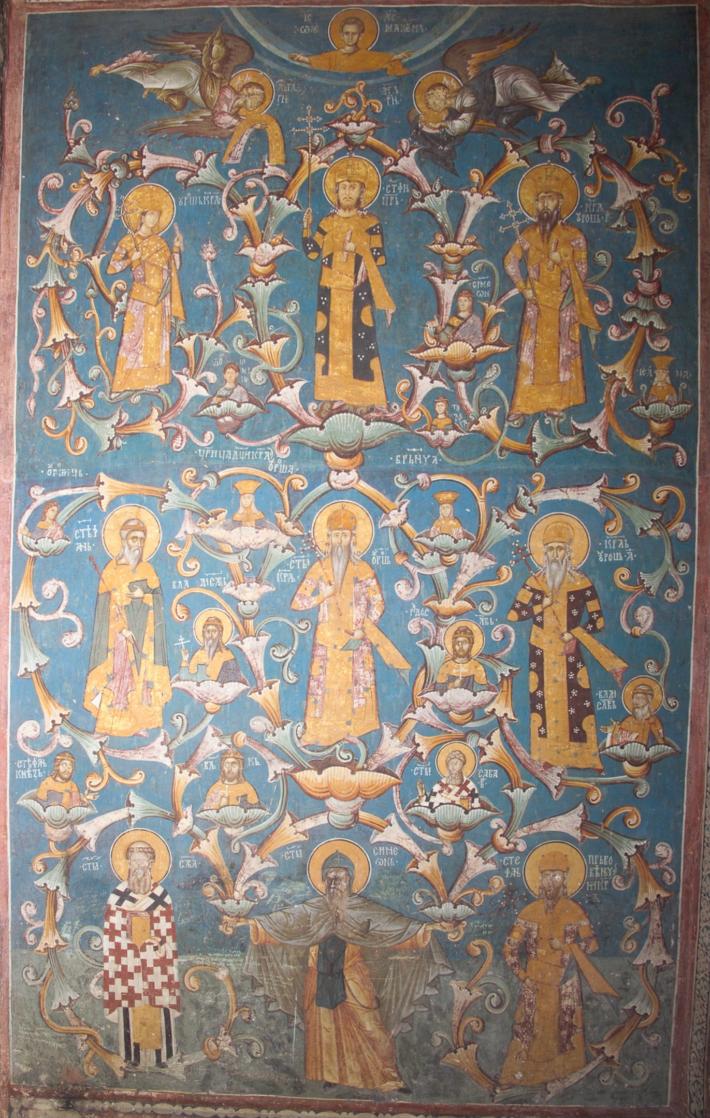Делимичан опис:
"СТЕФАН ПРВОВЕНЧАНИ КРАЉ СВЕ СРПСКЕ ЗЕМЉЕ СИН НЕМАЊЕ СИМЕОНА."
Partial description:
"STEFAN THE FIRST CROWNED KING OF ALL SERBIAN LANDS SON OF NEMANJA SIMEON."
Detail of the fresco from the Serbian orthodox monastery Studenica, 1235,Republic of Serbia
• СТЕ ПРbВО
ФАНb ВЂНbYА
НИКР
АΛb
СТЕФАН ПРВОВЕНЧАНИ КРАЉ
STEFAN THE FIRST CROWNED KING
Detail of the fresco "Nemanjic Family Tree" from the Serbian orthodox monastery Visoki Decani, Kosovo and Metohija, Republic of Serbia
: СТЕФАNb CNbNEMA
ПРbВОВЂНVА NHNb ⛬
NHIКРAb ⛬
СТЕФАН ПРВОВЕНЧАНИ КРАЉ СИН НЕМАЊЕ
STEFAN THE FIRST CROWNED KING SON OF NEMANJA
Detail of the fresco "Nemanjic Family Tree" from the Serbian orthodox monastery The Patriarchate of Pec, Kosovo and Metohija, Republic of Serbia
These coins belong to king Stefan The First-Crowned as the first mention of Serbian coins dates back to a document from 1214. These are first silver Serbian coins and first coin issues of Serbian Nemanjic state.
All our research and reasoning is on the following pdf article:

|
King Stefan The First Crowned and King Uros I coins v3.pdf Size : 22675.428 Kb Type : pdf |

|
Новац Краља Стефана Првовенчаног и Краља Уроша I в3.pdf Size : 23032.302 Kb Type : pdf |
King Stefan The First-Crowned (1217-1228). First Serbian king of the Nemanjic state.
Silver "banner" type. 20mm, 2.135g.
Obverse: King receiving banner from saint Stefan who is holding book of gospels decorated with 5 gems. Latin legend: STEFANV` REX SSTEFANV` (STEFAN KING SAINT STEFAN) around. + on the flag of the banner. Banner is represented with 4 lines.
Reverse: Christ enthroned, holding book of gospels decorated with 5 gems. Greek letters: IC XC (In Greek: Ιησούς Χριστός - Jesus Christ) above. 4 triple dotted pellets around the throne. Single circle, dot and a line next to the left foot. Saint has 3 dots on his chest and 3 dots on his right arm.
Reference: Jov 5 1.1, J 6 1.1, I 2.1, Lj V-15.
Comment: Extremely rare Tetovo type, found in Tetovo, Macedonia, in 1974 together with 225 Serbian medieval coins out of 4500 found. With lovely patina and intriguing decorative letters. R is portrayed in 3 parts, E in 4 parts with a half moon and a 3 dots and F with a upright line and a 2 dots. C on reverse is in 3 parts with couple triangles on each side. First S on the right side on the obverse is tilted upwards. Both names are missing letter S at the end of it.
At his coronation in 1217 he was crowned together with his second wife Anna Dandolo, first Serbian queen (1217–1258), married in 1207/1208, granddaughter of Venetian Doge Enrico Dandolo who was the 41st Doge of Venice from 1192 until his death in 1205. He was the first who minted Venetian matapan type coins a year after becoming Doge in 1193.
That period from first Venetian coin minted in 1193 to being minted by various cities by 1230 represented boom in popularity and expansion of matapan type. Rule of the first Serbian king Stefan The First-Crowned is right within it 1217-1228!
As he married Anna Dandolo in 1207 and a document mentions Serbian money in 1214 we can date this coin within that time frame, within those 7 years, 1207-1214!
Reference: #SFC07
Not For Sale.
Estimated Value: 300 - 400 - 500
Detail of fresco Loza Nemanjića, Stefan The First Crowned (son of Stefan Nemanja) Dečani, Serbia, 14th century.
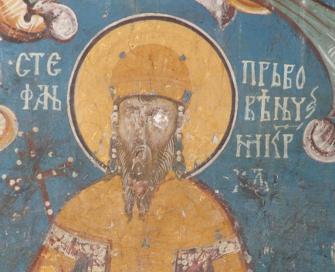
King Stefan The First-Crowned (1217-1228).
Silver "banner" type. 21mm, 2.103g.
Obverse: King receiving banner from saint Stefan who is holding book of gospels decorated with 5 gems. Latin legend: STEFANV` REX SSTEFANV` (STEFAN KING SAINT STEFAN) around. + on the flag of the banner. Banner is represented with 4 lines.
Reverse: Christ enthroned, holding book of gospels decorated with 5 gems. Greek letters: IC XC (In Greek: Ιησούς Χριστός - Jesus Christ) above. 4 triple dotted pellets around the throne. Single circle, dot and a line next to the left foot. Saint has 3 dots on his chest and 3 dots on his right arm.
Reference: Jov 5 1.1, J 6 1.1, I 2.1, Lj V-15.
Comment: Extremely rare Tetovo type, found in Tetovo, Macedonia, in 1974. With lovely goldenpatina and intriguing decorative letters. R is portrayed in 3 parts, E in 4 parts with a half moon and a 3 dots and F with a upright line and a 2 dots. C on reverse is in 3 parts with couple triangles on each side. First S on the right side on the obverse is tilted upwards. Both names are missing letter S at the end of it.
Reference: #SFC06
Not For Sale.
Estimated Value: 300 - 400 - 500
King Stefan The First-Crowned (1217-1228).
Silver "banner" type. 21mm, 2.096g.
Obverse: King receiving banner from saint Stefan (nimbate), holding book of gospels decorated with 5 gems. Latin legend: STEFAИV` REX SSTEFANV` (STEFAN KING SAINT STEFAN) around. + on the flag of the banner. Banner is represented with 3 lines.
Reverse: Christ enthroned, holding book of gospels decorated with 5 gems. Greek letters: IC XC (In Greek: Ιησούς Χριστός - Jesus Christ) above. 4 triple dotted pellets around the throne. Single or possibly two circles and a linenext to the left foot. Saint has 3 dots on his chest and 3 dots on his right arm.
Reference: D 7 10-21.
Comment: Very rare, arguably best preserved example of this type, with lovely patina and intriguing decorative letters. Not published by Jovanovic. R is portrayed in 3 parts, E in 4 parts with a half moon and a 3 dots and F with a upright line and a 2 dots. C on reverse is in 3 parts with couple triangles on each side. First S on the right side on the obverse is tilted upwards. Both names are missing letter S at the end of it. N letter on kings name is upside down.
Medieval Venice and Medieval Serbia both have matapan type coins.
Venetian coins on reverse have name of a Doge on the left and S.M.VENETI, saint Mark of Venice on the right. In between down the shaft just under flag there is the title DVX.
Serbian coins have name of the king on the left side and saint Stefan on the right, first century martyr, a disciple of Jesus who was stoned to death by Jews as observed by Saul the persecutor of Christians who himself later became a Christian, famous Apostle Paul. In between down the shaft just under flag there is the title REX.
That’s where differences end.
All coins have weight of 2.178g +/- 1% unless there are clipped or damaged and size 20-21mm. On obverse they have moneyer mark on the bottom left corner inside the throne next to Jesus foot, in the shape of a circle, a dot, a line or a star, line across the top of the throne that curves back towards it and the use of decorative letters.
Reference: #SFC01
Not For Sale.
Estimated Value: 300 - 400 - 500
Here we can see 4 king faces comparison. All show long hair, moustache and short beard. Difference is in the shape of the face and the way long hair falls over shoulders. Left 2 have lines on the top of kings chest, 4 lines top left and 3 lines bottom left. 2 on the right have no lines at all.
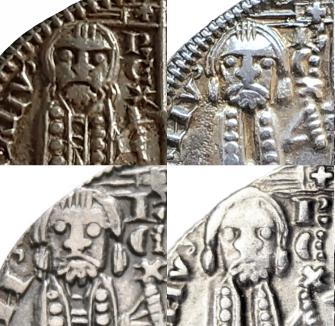
King Stefan The First-Crowned (1217-1228)
Silver "banner" type. 20mm, 2.026g.
Obverse: King receiving banner from saint Stefan (nimbate), holding book of gospels decorated with 5 gems. Latin legend: STEFANV` REX SSTEFANV` (STEFAN KING SAINT STEFAN) around. + on the flag of the banner. Banner is represented with 3 lines.
Reverse: Christ enthroned, holding book of gospels decorated with 5 gems. Greek letters: IC XC (In Greek: Ιησούς Χριστός - Jesus Christ) above. 4 triple dotted pellets around the throne. Single dot and a line next to the left foot. Saint has 3 dots on his chest and 3 dots on his right arm.
Reference: D 7 10-21.
Comment: Very rare variant with lovely patina and decorative letters. R is portrayed in 3 parts, E in 4 parts with a half moon and a 3 dots and F with a upright line and a 2 dots. C on reverse is in 3 parts with couple triangles on each side. First S on the right side on the obverse is tilted upwards. Both names are missing letter S at the end of it.
Very similar to one above, differences are moneyer marks. Instead of a circle and a line like example above this one has a dot and a line next to Jesus left foot.
Reference: #SFC10
Not For Sale.
Estimated Value: 300 - 400 - 500
King Stefan The First-Crowned (1217-1228)
Silver "banner" type. 21mm, 2.141g.
Obverse: King receiving banner from saint Stefan (nimbate), holding book of gospels decorated with 5 gems. Latin legend: STEFAИV` REX SSTEFAИV` (STEFAN KING SAINT STEFAN) around. + on the flag of the banner. Banner is represented with 3 lines.
Reverse: Christ enthroned, holding book of gospels decorated with 5 gems. Greek letters: IC XC (In Greek: Ιησούς Χριστός - Jesus Christ) above. 4 triple dotted pellets around the throne. Single dot next to the left foot. Saint has 3 dots on his chest and 3 dots on his right arm.
Reference: D 7 10-21.
Comment: Very rare variant with lovely patina and decorative letters. R is portrayed in 3 parts, E in 4 parts with a half moon and a 3 dots and F with a upright line and a 2 dots. C on reverse is in 3 parts with couple triangles on each side. First S on the right side on the obverse is tilted upwards. Both names are missing letter S at the end of it. N letters are upside down.
Very similar to one above, differences are moneyer marks. Instead of a circle and a line like example above this one has a single line next to Jesus left foot and a half circle almost like a half moon but facing downward, under Jesus right elbow.
Reference: #SFC04
Not For Sale.
Estimated Value: 300 - 400 - 500
King Stefan The First-Crowned (1217-1228)
Silver "banner" type. 20mm, 2.185g.
Obverse: King receiving banner from saint Stefan (nimbate), holding book of gospels decorated with 5 gems. Latin legend: STEFAИV` REX SSTEFAИV` (STEFAN KING SAINT STEFAN) around. + on the flag of the banner. Banner is represented with 3 lines.
Reverse: Christ enthroned, holding book of gospels decorated with 5 gems. Greek letters: IC XC (In Greek: Ιησούς Χριστός - Jesus Christ) above. 4 triple dotted pellets around the throne. Single dot and a line next to the left foot. Saint has 3 dots on his chest and 3 dots on his right arm.
Reference: D 7 10-21.
Comment: Very rare variant with lovely patina and decorative letters. R is portrayed in 3 parts, E in 4 parts with a half moon and a 3 dots and F with a upright line and a 2 dots. C on reverse is in 3 parts with couple triangles on each side. First S on the right side on the obverse is tilted upwards. Both names are missing letter S at the end of it. N letters are upside down.
Jovanovic puts it under Stefan Uros I.
Serbian churchmen Domentian or Domentijan (1210-1264), also known as Domentijan the Hilandarian who was a major figure in medieval Serbian literature and philosophy and a monk at the Hilandar Monastery, hence the name, wrote that the coronation was performed by a papal legate in 1217.
Few decades later Theodosius the Hilandarian (1246–1328), who was a Serbian Orthodox clergyman and one of the most important Serbian writers in the Middle Ages, claimed that Stefan was crowned by his brother Sava. The contradiction led some Serbian historians to conclude that Stefan underwent two coronations.
First by the papal legate in 1217 and second one by then first Serbian Archbishop Sava (1174-1236), in 1219, 2 years later.
Reference: #SFC02
Not For Sale.
Estimated Value: 300 - 400 - 500
Fresco of Stefan The First Crowned from Mileševa Monastery.
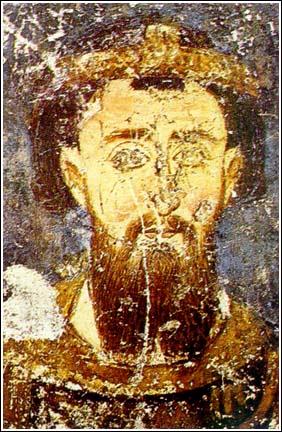
King Stefan The First-Crowned (1217-1228)
Silver "banner" type. 21mm, 2.161g.
Obverse: King receiving banner from saint Stefan (nimbate), holding book of gospels decorated with 5 gems. Latin legend: STEFAИ` REX SSTEFAN` (STEFAN KING SAINT STEFAN) around. + on the flag of the banner. Banner is represented with 3 lines. X letter next to the bottom of the banner.
Reverse: Christ enthroned, holding book of gospels decorated with 5 gems. Greek letters: IC XC (In Greek: Ιησούς Χριστός - Jesus Christ) above. 4 triple dotted pellets around the throne. Single star or a cross and a line next to the left foot. Saint has 3 dots on his chest and 3 dots on his right arm.
Reference: D 7 10-21.
Comment: Same clear image of the king but saint head is unusually large. Kings attire has 4 lines on the top over top of his chest. Very rare variant with lovely patina and decorative letters. R is portrayed in 3 parts, E in 4 parts with a half moon and a 3 dots and F with a upright line and a 2 dots. C on reverse is in 3 parts with couple triangles on each side. First S on the right side on the obverse is tilted upwards. Both names are missing letter VS at the end of it.
Moneyer mark is either a star or a cross but it looks like a fat letter T.
Reference: #SFC09
Not For Sale.
Estimated Value: 300 - 400 - 500
King Stefan The First-Crowned (1217-1228)
Silver "banner" type. 20mm, 1.922g.
Obverse: King receiving banner from saint Stefan (nimbate), holding book of gospels decorated with 5 gems. Latin legend: STEFAИV` REX SSTEFAИV` (STEFAN KING SAINT STEFAN) around. + on the flag of the banner. Banner is represented with 3 lines.
Reverse: Christ enthroned, holding book of gospels decorated with 5 gems. Greek letters: IC XC (In Greek: Ιησούς Χριστός - Jesus Christ) above. 4 triple dotted pellets around the throne. Single dot and a line next to the left foot. Saint has 3 dots on his chest and 3 dots on his right arm.
Reference: D 7 10-21.
Comment: Nice clear image of the king and saint, slightly clipped. Kings attire has 3 lines on the top over top of his chest. Very rare variant with lovely patina and decorative letters. R is portrayed in 3 parts, E in 4 parts with a half moon and a 3 dots and F with a upright line and a 2 dots. C on reverse is in 3 parts with couple triangles on each side. First S on the right side on the obverse is tilted upwards. Both names are missing letter S at the end of it.
Reference: #SFC05 (SOLD)
King Stefan The First-Crowned (1217-1228)
Silver "banner" type. 20mm, 2.150g.
Obverse: King receiving banner from saint Stefan (nimbate), holding book of gospels decorated with 5 gems. Latin legend: STEFAИ` REX SSTEFAИ` (STEFAN KING SAINT STEFAN) around. + on the flag of the banner. Banner is represented with 3 lines. Single dot on the bottom.
Reverse: Christ enthroned, holding book of gospels decorated with 5 gems. Greek letters: IC XC (In Greek: Ιησούς Χριστός - Jesus Christ) above. 4 triple dotted pellets around the throne. Single star and a line next to the left foot. Saint has 3 dots on his chest and 3 dots on his right arm.
Reference: D 7 10-21.
Comment: Nice but different image of the king and saint. Kings attire has no lines on the top over top of his chest like examples above. Very rare variant with lovely patina and decorative letters. R is portrayed in 3 parts, E in 4 parts with a half moon and a 3 dots and F with a upright line and a 2 dots. C on reverse is in 3 parts with couple triangles on each side. First S on the right side on the obverse is tilted upwards. Both names are missing letter VS at the end of it.
Reference: #SFC08
Not For Sale.
Estimated Value: 300 - 400 - 500
King Stefan The First-Crowned (1217-1228)
Silver "banner" type. 19mm, 1.804g.
Obverse: King receiving banner from saint Stefan (nimbate), holding book of gospels decorated with 5 gems. Latin legend: STEFAИ` REX SSTEFAH` (STEFAN KING SAINT STEFAN) around. + on the flag of the banner. Banner is represented with 3 lines.
Reverse: Christ enthroned, holding book of gospels decorated with 5 gems. Greek letters: IC XC (In Greek: Ιησούς Χριστός - Jesus Christ) above. 4 triple dotted pellets around the throne. Single star and a line next to the left foot. Saint has 3 dots on his chest and 3 dots on his right arm.
Reference: D 7 10-21.
Comment: Nice clear image of the king. Unlike 2 examples above, kings attire has 3 lines on the top over top of his chest. Very rare variant with lovely patina and decorative letters. R is portrayed in 3 parts, E in 4 parts with a half moon and a 3 dots and F with a upright line and a 2 dots. C on reverse is in 3 parts with couple triangles on each side. First S on the right side on the obverse is tilted upwards. Both names are missing letter VS at the end of it. First N letter on the left is upside down and second looks like H.
Reference: #SFC03 (SOLD)
Stefan The First Crowned (Prvovenčani), begining of the XIV century (1307—1309), fresco from Bogorodica Ljeviška church in Prizren, Serbia.
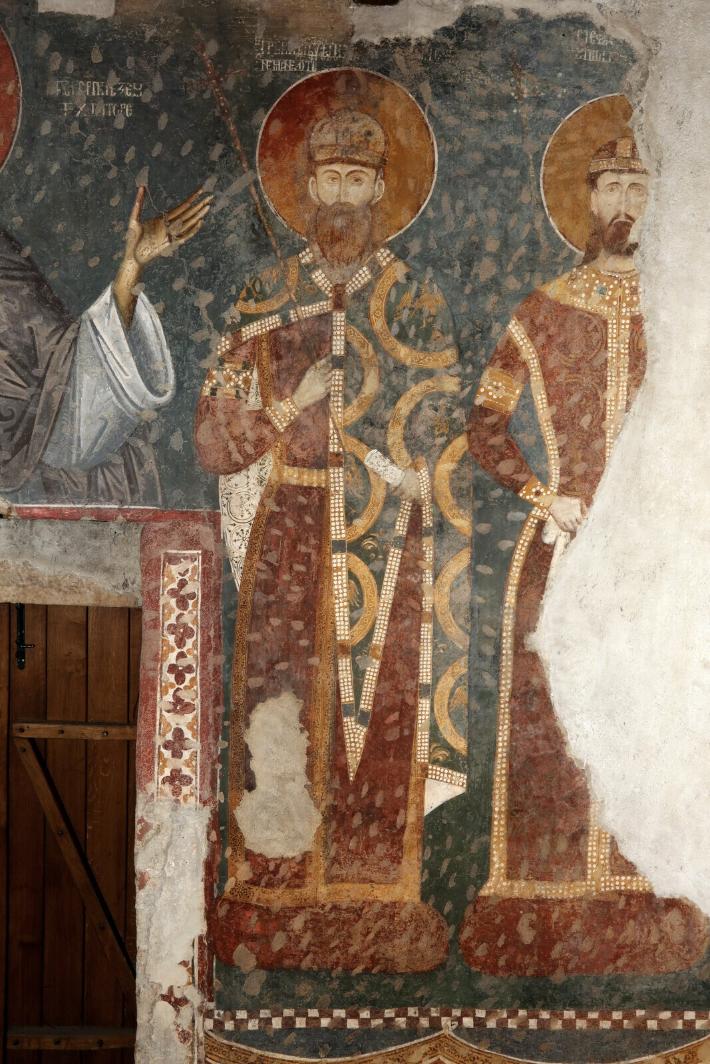
Nemanjic Royal Family Tree (Loza Nemanjica) Decani, Serbia XIV century.
Royal family tree starts from the bottom right to the left and up. In the middle there is a founder of Serbian state, Stefan Nemanja (1113-1199). All kings took his name as a royal title. On the left is his son Sava (1174-1236) who became a first Serbian Archbishop and who crowned his older brother Stefan The First Crowned (1166-1228), here on the right, in the monastery Zica in 1219.
Above them second line are 3 smaller images, Vukan Nemanjić (1165-1207), second image from the left, who was the Grand Prince of the Grand Principality of Serbia from 1202 to 1204. He was the Grand Prince of Pomorje (titular King) from 1195 until his death in 1207. He was the eldest son of Stefan Nemanja (of three), but his father had instead chosen his younger brother Stefan as heir. He sadly never lived long enough to see his younger brother being crowned as a first Serbian king. On his left is his son Stefan Vukanović Nemanjić, titled knez ("prince") he had two brothers, the eldest Djordje, who was the Grand Prince of Zeta (1208-1216), and youngest Dmitar, a župan (county lord) and monk. In 1252, Stefan Vukanović built the Morača monastery. On his right is Sаvа II (1200-1271) who was third Serbian Archbishop (1263-1271). He was son of Stefan The First Crowned.
Third line starts with a small image of Stefan Vladislav I (1198-1264) who was the King of Serbia from 1234 to 1243. He was the middle son of Stefan the First-Crowned and Queen Eudokia Angelina daughter of Byzantine Emperor Alexios III Angelos and Euphrosyne Doukaina Kamatera. Followed by large image of Uros I known as Uros the Great who was the King of Serbia from 1243-1276, succeeding his brother Stefan Vladislav I. He was one of the most important rulers in Serbian history and was the youngest son of Stefan the First-Crowned and Anna, the granddaughter of Enrico Dandolo, Doge of Venice. Left from Uros I is small image of king Radoslav (1192-1235), king of Serbia (1228-1234), eldest son of Stefan The First Crowned.
Copyright © 2020
